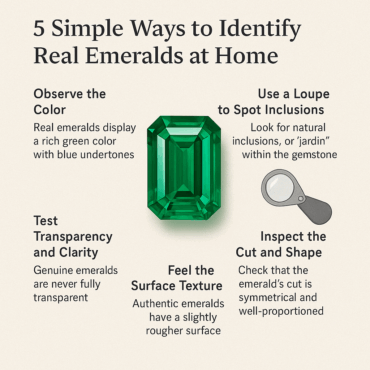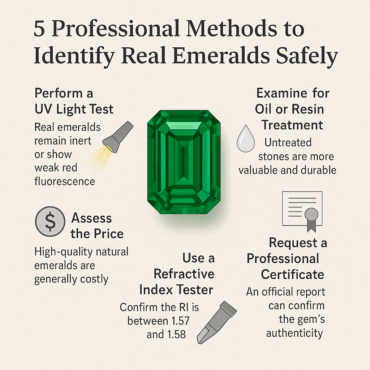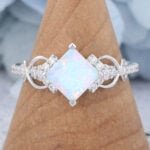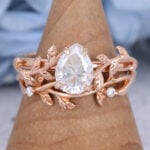How to Identify Real Emerald Stones vs Fake: 10 Easy Ways to Avoid Damaging Gemstones
Emeralds have long been treasured for their rich, vibrant hues and enchanting history. However, with the market flooded by synthetic and imitation stones, it has become crucial to identify real emerald jewelry without causing damage. In this guide, we will explore ten safe, practical ways to detect genuine emeralds while preserving their natural beauty.
Understanding the Value of Emerald Jewelry
Emerald jewelry, especially emerald rings, holds a timeless allure. Natural emeralds are celebrated for their depth of color, natural inclusions, and rarity. Authentic pieces often feature a slightly mossy texture known as ‘jardin,’ adding to their unique charm. Whether set in green emerald engagement rings, necklaces, or bracelets, genuine emeralds symbolize wisdom, growth, and renewal, making them cherished heirlooms.

Real vs. Fake Emeralds: Understanding the Key Differences
While authentic emeralds captivate with their natural inclusions, rich green hues, and distinctive glow, fake emeralds often lack this depth and vibrancy. Genuine emeralds usually show tiny imperfections known as ‘jardin’, whereas synthetic or imitation stones may appear too perfect or overly clear. The texture, brilliance, and even the way light reflects within a true emerald differ noticeably from fakes. Knowing these subtle yet crucial differences is essential for anyone looking to identify real emerald jewelry with confidence.
5 Simple Ways to Identify Real Emeralds at Home
1. Observe the Color
The first and easiest way to identify real emerald stones is by observing their color. True emeralds exhibit a deep, slightly bluish-green tone. If the color appears too vivid, uniform, or neon-like, it might be an imitation. Natural stones often display slight variations and layered depths in their hues, setting them apart from synthetic creations.
2. Use a Loupe to Spot Inclusions
Magnifying the stone with a jeweler’s loupe can help detect authentic features. Real emeralds commonly have visible internal inclusions that resemble tiny gardens, known as ‘jardin.’ In contrast, fake or synthetic stones may show bubbles, or perfectly arranged lines. Spotting these natural imperfections can help you tell if the gem is truly authentic.
3. Test Transparency and Clarity
Genuine emeralds typically have some cloudiness or inclusions that affect their clarity. An emerald that looks overly clear, flawless, and perfect might not be the real deal. Learning to detect natural imperfections is key when you want to identify real emerald jewelry confidently.
4. Inspect the Cut and Shape
The cutting style provides another clue. Emeralds are often fashioned into the classic ’emerald cut’—a rectangular or square shape with truncated corners. Overly sharp edges or unusually perfect cuts might hint at a synthetic origin. Always pay attention to symmetry and craftsmanship details to spot authentic emeralds.
5. Feel the Surface Texture
Touching the gem with clean fingers can offer tactile information. A real emerald feels cool to the touch and may have a slightly textured surface. Fakes often feel overly smooth or warm quickly in your hand. Though not foolproof alone, combining this method with others helps accurately identify real emerald pieces.

5 Professional Methods to Identify Real Emeralds Safely
1. Perform a UV Light Test
Under UV light, genuine emeralds typically show little to no fluorescence. Imitations or heavily treated stones may glow unnaturally. This non-invasive technique is widely used to detect authenticity without harming the gem.
2. Examine for Oil or Resin Treatment
Natural emeralds often receive oil treatments to enhance their appearance. Observing under strong lighting can reveal tiny oil-filled fractures or a faint cloudy appearance. While treatment is common, a completely flawless stone with no visible treatments could signal a synthetic origin.
3. Assess the Price
A surprisingly low price tag should immediately raise concerns. Authentic emeralds, especially high-quality ones, are expensive. If a deal seems too good to be true, it probably is. Always be skeptical and rely on trusted sources to identify real emerald jewelry wisely.
4. Request a Professional Certificate
Reputable sellers should provide certificates from recognized gemological laboratories such as GIA, IGI, or GRS. Certification verifies the stone’s origin, treatments, and natural authenticity. Learning to read these documents is crucial when trying to identify real emerald accurately.
5. Use a Refractive Index Tester
Professionals often measure the emerald gemstone’s refractive index. Authentic emeralds fall between 1.565 and 1.602. Glass imitations or other stones usually show different values. This method allows you to detect real emeralds scientifically without any damage.

Bonus Tip: Consult a Gemologist When Unsure
If after applying these techniques you still feel uncertain, it’s wise to consult a professional gemologist. Experts have the right tools and knowledge to identify real emerald gemstones definitively. Avoid at-home destructive methods like scratching or acid testing, which can ruin a beautiful gem.
Conclusion
Learning to identify real emerald stones without causing harm ensures your precious investments remain intact and beautiful. Whether using simple at-home techniques or more advanced professional methods, taking the time to verify authenticity protects both your wallet and your admiration for nature’s wonders. By following these ten non-damaging strategies, you can shop confidently and cherish your emerald jewelry for generations.
FAQs About Identify Real Emerald
How to tell if an emerald is real?
You can tell if an emerald is real by checking its color, clarity, and inclusions. Genuine emeralds often have natural flaws, while fakes look too perfect. A gemologist’s test is the most reliable way.
Are real emeralds ever completely flawless?
No, natural emeralds usually have visible inclusions or tiny internal flaws. If a stone appears flawless, it might be synthetic or treated heavily with resins.
Can UV light help identify a fake emerald?
Yes. Most real emeralds do not fluoresce under UV light. If your emerald glows bright red or orange under UV, it could be a fake or synthetic stone.
Is it true that real emeralds feel colder than fake ones?
Yes. Real emeralds are natural minerals and feel cooler to the touch than glass or plastic imitations, which warm up quickly.
Do real emeralds always come with a certificate?
Not always, but reputable sellers will provide a gemological certificate verifying authenticity. Always request one for high-value purchases.
Can synthetic emeralds pass as real?
They can appear very similar but are lab-created. While they have the same chemical structure, their value is significantly lower than natural emeralds.



